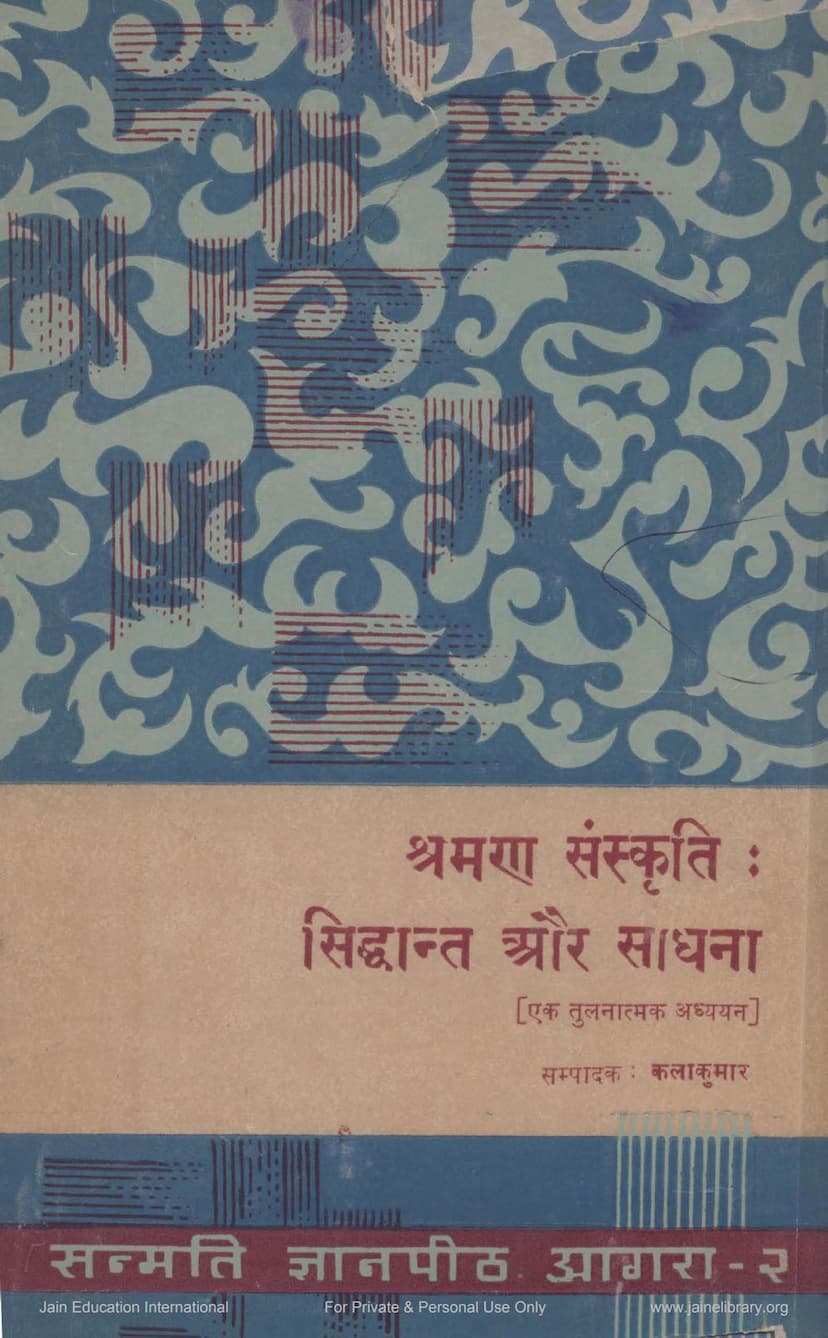Shraman Sanskruti Siddhant Aur Sadhna
Added to library: September 2, 2025

Summary
This is a comprehensive summary of the Jain text "Shraman Sanskruti: Siddhant aur Sadhna" (Shraman Culture: Principles and Practice) edited by Kalakumar, published by Sanmati Gyan Pith, Agra. The book is a collection of essays by various scholars exploring the principles and practices of Shraman culture, with a comparative approach.
Overall Theme:
The book aims to provide a deep and scientific understanding of Shraman culture, highlighting its principles (Siddhant) and practices (Sadhna). It emphasizes the significant contribution of Shraman thought to the formation of Indian culture, contrasting it with the Vedic tradition and showcasing their eventual synthesis. The core tenets of Shraman culture, such as ethics, self-reliance, introspection, intellectual freedom, and the pursuit of spiritual liberation, are explored.
Key Themes and Chapters (as indicated by the table of contents and summaries):
- The Essence of Shraman Culture: The book begins by defining Shraman culture as one based on equality ("Samata") in society, goals, and towards all living beings. This equality is achieved through virtue and effort, not birth. The ultimate goal is the eradication of all selfish desires. The term "Shraman" itself is derived from "Shram" (effort) and "Sham" (peace, control), signifying a culture of self-effort, self-control, and peace.
- Principles of Shraman Culture:
- Equality (Samata): Social equality, regardless of birth or gender, is a cornerstone. Equality in ultimate goals (liberation) and equality in recognizing the inherent worth of all living beings.
- Ethics and Morality (Sadaachar): Emphasis on virtuous conduct as central to the culture, reflected in art, architecture, and daily life.
- Optimism: The culture instilled hope and resilience, particularly during challenging times, contributing to India's cultural resistance.
- Intellectual Freedom (Chintan Swatantrya): A tradition of healthy philosophical inquiry and the free exploration of diverse viewpoints.
- Ahimsa (Non-violence): Considered the highest principle, encompassing mental, verbal, and physical non-violence towards all beings, from the smallest to the largest, and including all forms of life (earth, water, fire, air, plants). It is seen as the foundation for peace, friendship, and compassion.
- Anekantavada (Non-absolutism/Plurality of Viewpoints): This philosophical doctrine, particularly prominent in Jainism, promotes intellectual non-violence by acknowledging multiple perspectives and avoiding rigid, one-sided views. It's presented as a way to resolve conflicts and foster understanding.
- Syadvada: The linguistic application of Anekantavada, acknowledging that any statement is true only from a particular viewpoint ("Syat").
- Tyaga (Renunciation/Detachment): The core principle of Jain culture, involving the renunciation of possessions, desires, and attachments as the path to happiness and liberation.
- Karma Yoga and Self-Reliance: The belief that individuals are responsible for their own actions and destiny, emphasizing self-effort and spiritual development rather than reliance on external forces.
- Historical and Philosophical Roots:
- Ancient Origins: The text argues for the antiquity of Shraman culture, predating or being contemporaneous with Vedic culture, citing evidence from archaeological findings (Mohenjo-daro, Harappa), Vedic literature (Vratya, Vatrasana), and historical accounts (Megasthenes).
- Key Figures: The contributions of various Tirthankaras, particularly Rishabhadeva (the first Tirthankara) and Mahavira (the last Tirthankara), are highlighted as foundational. The influence of figures like Buddha is also discussed.
- Comparison with Vedic Culture: While acknowledging the synthesis between Vedic and Shraman traditions, the book distinguishes their core orientations: Vedic culture is seen as more pravritti-pradhan (action-oriented, worldly engagement) while Shraman culture is nivritti-pradhan (renunciation-oriented, inward focus).
- Influence on Other Religions: The principles of Shraman culture, especially Ahimsa, are shown to have influenced other religions and philosophical traditions, including Buddhism, Hinduism, Islam, Christianity, and Judaism.
- Shraman Culture in Practice:
- The Role of Monastics (Shramanas) and Laity (Shravakas): The text acknowledges the crucial role of both ascetics (monks and nuns) and householders in preserving and propagating Shraman culture. The lives and contributions of prominent Jain and Buddhist disciples are detailed.
- Practices: Emphasis is placed on practices like meditation (Samayika), ethical conduct, detachment, and the pursuit of spiritual knowledge.
- Social Impact: The culture's impact on social structures, advocating for equality and the rejection of rigid caste systems, is discussed.
- Art and Literature: The rich artistic and literary heritage influenced by Shraman culture, particularly in Prakrit, Sanskrit, Gujarati, and Kannada languages, is explored.
- Relevance to Modern Times:
- Addressing Contemporary Issues: The book suggests that the core principles of Shraman culture, particularly Ahimsa, Anekantavada, and Aparigraha (non-possession), offer solutions to modern-day problems like violence, conflict, inequality, and materialism.
- Need for Revival: There's an underlying call for the re-emphasis and practical application of these ancient principles in contemporary society.
Key Contributors (as mentioned in the text):
The book features contributions from various scholars and spiritual leaders, including:
- Upadhyay Amarmuni
- Krishnadatt Bajpai
- Devendra Muni Shastri
- Dr. Bhagchand Jain Bhaskar
- Dr. Pushyamitra Jain
- Pt. Vijay Muni Shastri
- Dr. Ramdhari Singh 'Dinkar'
- Shri Agarchand Nahata
- Muni Shri Nagaraj, D. Litt.
- Shri Shrichand Surana 'Saras'
- Dr. Madhav Shri Randive
- Shri Saubhagyamal Jain, Advocate
- Sadhavi Shri Chandanaji, Darshanacharya
- Shri Rishabhdas Ranka
- Dr. Bhagwatswarup Mishra
- Dr. Parasnath Dwivedi
- Dr. Mahendra Sagar Pranchadiya
- Sadhvi Manjushriji
- Prof. Ramashray Prasad Singh
- Kalakumar (Editor)
Overall Significance:
"Shraman Sanskruti: Siddhant aur Sadhna" is presented as a significant academic and spiritual endeavor to illuminate the profound and enduring legacy of Shraman culture. It positions Shraman principles as not just ancient doctrines but as relevant and vital for contemporary ethical, social, and spiritual well-being, offering a path towards global peace and harmony. The book's comparative approach helps to understand Shraman culture within the broader context of Indian intellectual history.